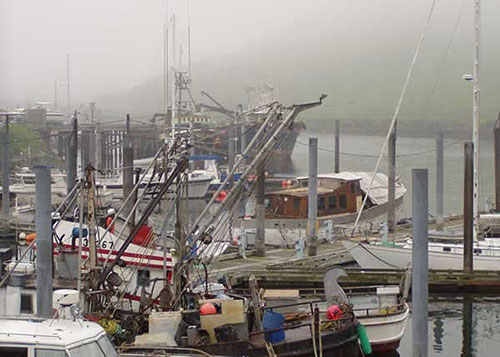
Scientists Establish Baseline to Gauge How Alaska Communities Will Respond to Change
February 19, 2016
Friday AM
(SitNews) - In a new study by NOAA Fisheries, scientists looked at 347 Alaska communities to assess their dependence on marine resources and socio-economic well-being. This is the first time that NOAA Fisheries has used “quantitative” indicators for this type of assessment in Alaska. Scientists hope to provide marine resource managers with a scientifically sound rapid assessment of community resiliency over time.
“In many places throughout Alaska, reliance on marine resources is central to the way people live. Over 90 percent of Alaska’s rural residents rely on wild-caught food for part if not all of the year,” said Doug DeMaster, Director, Alaska Fisheries Science Center.

A small boat harbor in Dutch Harbor, Alaska.
Courtesy NOAA Fisheries
“We need to carefully consider how changes affect these communities. These changes can be regulatory. They can include national and international forces such as recessions, fuel prices and monetary exchange rates. They can result from environmental factors like shifts in fish stock abundance or environmental disasters. We also need to better understand how well these communities can adapt to these changes,” he said.
In general, the communities with the lowest socioeconomic well-being are found in western Alaska, where few economic opportunities exist. On the other hand, the majority of communities with the highest fisheries involvement indices are located in southcentral and southeast Alaska. Here, local residents are heavily involved in commercial, recreational and/or subsistence harvesting or processing.
It is not easy to assess community well-being, resilience, and vulnerability. Typically, scientists have to rely on time intensive and expensive field surveys to collect this type of information. However, by using a common set of indicators from already existing secondary data that consider things like household income, population composition, the cost of housing, employment, and the types of fishing businesses that people are engaged in, scientists could assess these communities rapidly. Using this consistent approach across regions of the US, scientists are able to do cross-regional and nationwide analysis.
“Not surprising is that all the Alaska communities studied are unique, having different values for each of the indices compared. As a result, we expect they will respond to perturbations differently. However, we now have a consistent and quick way to measure these impacts. Resource managers can, in turn, make headway in advancing ecosystem-based fishery management because they will have access to timely socio-economic information,” said Stephen Kasperski, social scientist, Alaska Fisheries Science Center.
On the Web:
See: About Social Indicators for more information.
Click here to view how Alaska communities compare to other US fishing communities.
Community Profiles for Southeast Alaska
http://www.afsc.noaa.gov/REFM/Socioeconomics/
Projects/communityprofiles/Regional_Southeast_Alaska.pdf
Community Profiles for North Pacific Fisheries - Alaska
http://www.afsc.noaa.gov/REFM/Socioeconomics/Projects/CPU.php
Communities & Fisheries in Alaska Snapshots
http://www.afsc.noaa.gov/REFM/Socioeconomics/
Projects/communitysnapshots/main.php
Edited by Mary Kauffman, SitNews
Source of News:
NOAA Fisheries
http://www.afsc.noaa.gov
Publish A Letter in SitNews
Contact the Editor
SitNews ©2016
Stories In The News
Ketchikan, Alaska
|
Articles &
photographs that appear in SitNews may be protected by copyright
and may not be reprinted without written permission from and
payment of any required fees to the proper sources.
E-mail your news &
photos to editor@sitnews.us
Photographers choosing to submit photographs for publication to SitNews are in doing so granting their permission for publication and for archiving. SitNews does not sell photographs. All requests for purchasing a photograph will be emailed to the photographer.
|
|

